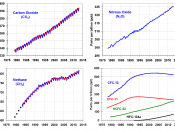1st Year Project - Communication in OrganisationsChevron's Human Energy CampaignContentAbstract2Introduction4Background4Chevron Corporation4Perspective of this paper4Research question4Research method/design5Hypothetical reflections5Method5Data collection5Theoretical approach5Delimitation5The Campaign ads6Change of wording6Versatile Campaign7What kind of Communication is Chevron using in their Human Energy Campaign?8Scientific Persuasion & Target Population9Mass Communication11Two-step flow of information model11Opinion leaders12Diffusion of Innovations theory12Communication as strategic control13Communication as strategic ambiguity14Is Chevron and its Human Energy Campaign trustworthy?16Danish Survey Study16Is Human energy really that humane?17Creating trust through emotions18Why does the Campaign need changes?19Culture & communication19Theoretical framework19Theories of face and culture19Differences between USA and Denmark20Advertising effects and culture21Chevrons campaign and culture22Who is the target group?22Traces of Chevrons target group23Target group discussion23Testing the campaign in Denmark25Survey25Survey data25Survey interpretation26Survey implications27Conclusion28References29Appendix31Greenhouse gases affect the atmosphere31Car manufactures and the environment31Kyoto Protocol31USA is not supporting the Kyoto Protocol32Campaign against the environment32Chevron - a brief profile33Culture as "form" and "function"34Emic and Etic study approaches34Cultural variability34Individualism/masculinity and collectivism/femininity35The survey questions35Detailed results scheme from survey36Sample error37IntroductionBackgroundOil companies face many difficult challenges these days.
The consumption of oil reached 83 million barrels per day in 2004 (EIA, 2007) and estimations tells that it will reach 118 million barrels per day in 2030 (EIA, 2007). Prises per barrel of oil reached 144 US Dollar (Mouawad, 2008), causing prises on daily good to increase, because of the increasing transportation-cost and the greenhouse gases (See Appendix, Greenhouse gases affect the atmosphere) that are released into the atmosphere are causing a global warming. Dealing with such problems, several of the worlds leading car manufactures are currently developing future products that either emits less greenhouse gases (using less fuel/particle-filters) or products that run on none-oil-based fuel (See Appendix, Car manufactures and the environment). This represents a great challenge for oil companies in terms of selling oil. Yet, an even greater challenge presents its self through a worldwide climate agreement, named the Kyoto...


